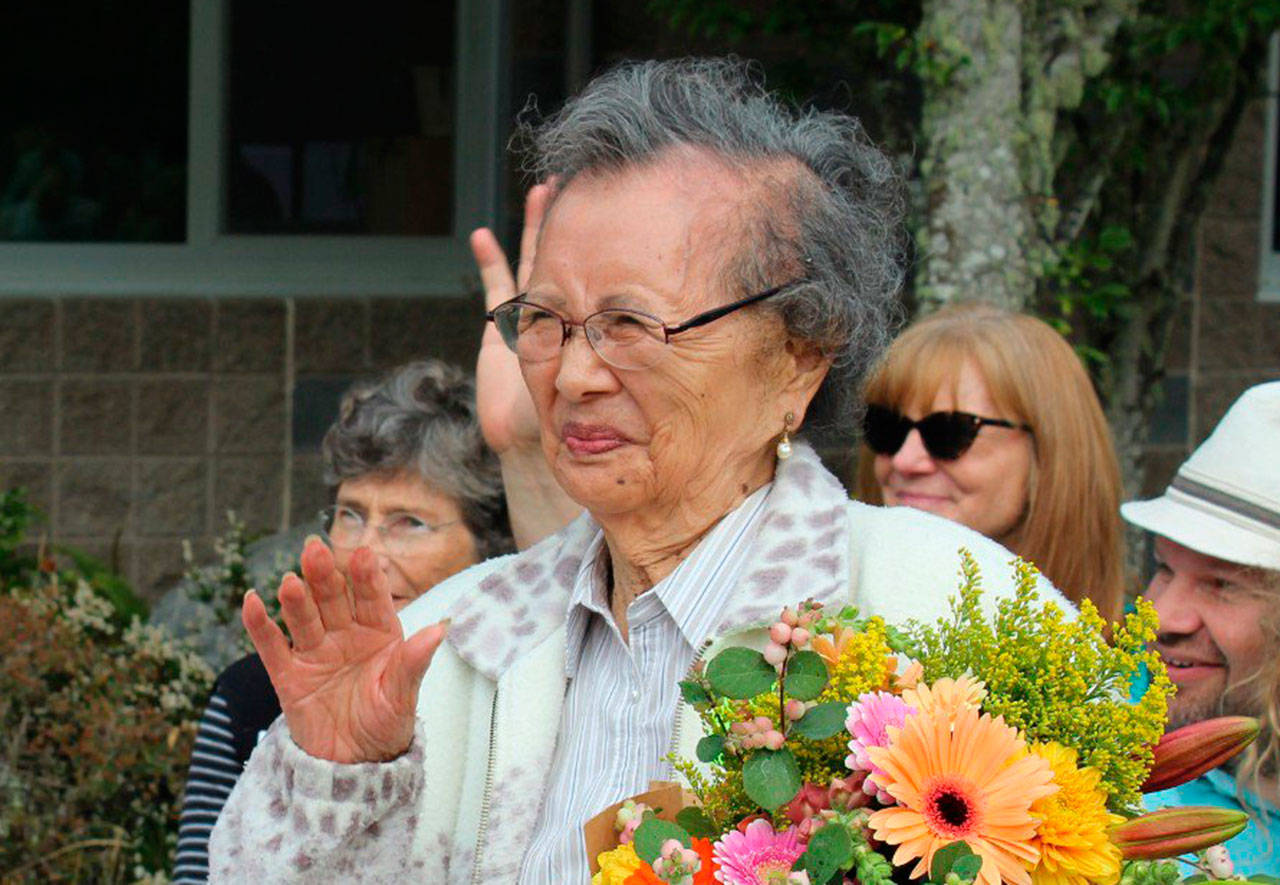Kazuko “Kay” Sakai Nakao celebrates her 100th birthday Friday. As illustrated in Cameron Snow’s wonderful 2015 documentary about the Sakai family, Kay is a heck of a storyteller. And what stories she has to tell!
Kay’s father Sonoji Sakai came to Bainbridge Island in 1915, and her mother Yoshiko followed from Japan soon after. By the time Kay was born in 1919 the community at Yama near Blakely Harbor was already the booming center of Japanese life on the Island. The Sakai family rented a house, where they lived until 1935 with no electricity or indoor plumbing, near the current Island Village shopping center from Captain Wilkes.
Japanese families on Bainbridge initially gravitated to agriculture. By the time Kay was 4 years old Bainbridge strawberries were already famous, the cannery at Strawberry Cove had been built, and the Harui family had established Bainbridge Gardens at Island Center.
When they came to Bainbridge Island Kay’s parents spoke no English, but those who know Kay will not be surprised that she caught on very quickly when she started first grade. By then, she and her siblings were helping their father in the strawberry fields. As Kay tells it, he took advantage of the fact that his children were built close to the ground and had them tending the plants from an early age.
By the start of the Great Depression, at the ripe old age of 10 Kay was baby-sitting her younger siblings and doing the housework during strawberry season while both her parents were working the farm. During the school year, she walked a mile to attend Lincoln Grade School.
In 1935, Kay’s father decided to build the family a new home. The Japanese community came together to help build the house, and in 1936 the family moved into their new home, with electricity and indoor plumbing, located on land where Ordway School now stands. Interestingly, this was the same year that construction of historic Lynwood Center was completed. That same year Kay’s father purchased wooded property stretching from the corner of High School Road and Madison Avenue north past Ordway. The next years were spent clearing that property, which soon was producing strawberries.
When she graduated from Bainbridge High School in 1938, Kay had hoped to go to business college in Seattle. However, her parents told her that her help was needed on the farm, and with caring for her younger siblings, so Kay’s next four years were spent becoming a young adult on Bainbridge Island.
December 7, 1941 changed everything. Fear and uncertainty reigned from that day until Executive Order 1066 decreed that all people of Japanese descent on the west coast would have to leave their homes. It was a scary time, Kay said. Bainbridge Islanders were the first to be sent to the concentration camps, given a scant six-day notice that they would leave on March 30, 1942. A photograph of Kay, age 22, and her father taken on March 29 shows them surveying the strawberry fields, and the home they would leave behind.
Kay tells the story of the events to follow — the ferry ride to Seattle, the trip first to Manzanar in California, and later to Minidoka, near Twin Falls, Idaho; of the small and not so small privations of the camps; and of the indominable spirit of those incarcerated — with a mix of wonder and sadness, but at the same time with humor and without rancor. She had a boyfriend from the Island, Isami “Sam” Nakao, who became her husband while they were at Minidoka, and in her telling you can almost taste the fried chicken she and Sam shared on their one-day honeymoon. Her oldest son, Bruce, was born at Minidoka. The family returned to Bainbridge Island in 1945, where children Bill and Anne joined the family. As Kay tells it, for the most part they were welcomed home, and life soon returned to normal.
In 1949, Kay’s father was asked to sell part of his farm so a new school could be constructed. Sonoji and Yoshiko Sakai were grateful for the education that their children had received and sold the land where Commodore School now stands for what they had paid for it years earlier.
When Town & Country Market opened in 1957, Kay found a place in the check stand that she occupied for the next 25 years, a familiar and friendly face to generations of Islanders.
The story of the Japanese American Exclusion and its impact on the lives of so many loyal Japanese Americans was little known until community elders led by Junkoh Harui, Frank Kitamoto, Don and Ron Nakata and John Sakai started an oral history project in the late 1970s. That project led to the establishment of the Japanese American Exclusion Memorial in 2002 and the dedication of the Memorial’s Story Wall in 2011. It also led to a new sixth-grade curriculum studying the Japanese American Exclusion experience at the appropriately named Sonoji Sakai Intermediate School. Kay Nakao has been an active participant in that educational experience every year since 2004, doing her part to ensure that the wrongs perpetrated on Japanese Americans during World War II will never be repeated.
Celebration of Kay Nakao’s 100th birthday is also a celebration of the “modern” history of Bainbridge Island, which she has personally lived so fully. Town & Country Market will honor Kate at 10 a.m. today, Dec. 13. Governor Jay Inslee will join in honoring Kay at Sonoji Sakai Intermediate School at 11 a.m. Saturday, Jan. 11. All are welcome.
Val Tollefson is the President of the Bainbridge Island Japanese American Exclusion Memorial Association.



